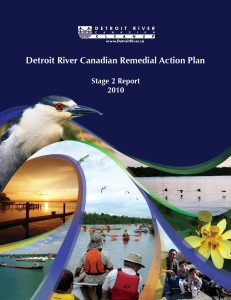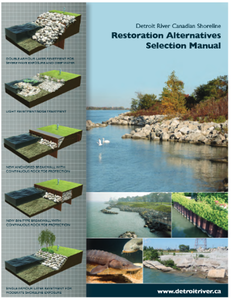Technical Reports
Detroit River Remedial Action Plan Stage 1 Report (1990): describes the history of contamination, sources of pollution, relevant regulatory programs, and identifies beneficial use impairments relevant to the Detroit River Area of Concern. Download the Detroit River Remedial Action Plan Stage 1 Report (binational) report.
Detroit River Remedial Action Plan Stage 2 Report (2010): the second stage of the Remedial Action Plan (RAP) required by the Great Lakes Water Quality Agreement. The Canadian RAP Stage 2 Report identifies actions required to restore beneficial uses in the Detroit River Area of Concern. Please note that information from both Canadian and U.S. sources was utilized to write the report but the focus of the summaries, analyses, and recommended actions is for the Canadian side of the Detroit River AOC only.
Pathway to Delisting (2025): This document outlines the remaining actions necessary to delist the Canadian side of the Detroit River as an Area of Concern. The Pathway to Delisting is updated annually. Download the Detroit River Canadian Delisting Plan report.
Detroit River Canadian Shoreline Restoration Alternatives Selection Manual (2011): this document was developed to guide shoreline restoration efforts for private landowners working within the Detroit River AOC, and also to assist the DRCC partnership in determining the suitability of various sites for implementing fish habitat enhancement works. Download the manual here.
|
Restoration Manual |
Beneficial Use Impairments (BUIs) Re-Designation Reports
The following reports have been published by the DRCC and contribute to beneficial use impairment re-designations.
| Beneficial Use Impairment and Criteria | Report | Status |
|
Tainting of Fish and Wildlife Flavour (BUI #2)…will be considered not impaired when survey results confirm that there is no statistically significant tainting of fish flavor when compared to fish from upstream of the Detroit River. |
Re-Designation Report: Assessment of the Tainting of Fish and Wildlife Flavour (BUI #2) in the Detroit River Area of Concern |  |
| Degradation of Aesthetics (BUI#11)…will be considered not impaired when the waters are devoid of substances at levels that produce persistent objectionable deposits, colours, turbidity, and/or odour. | Re-Designation Report: Assessment of Degradation of Aesthetics (BUI #11) in the Detroit River Area of Concern |  |
| Beach Closings (BUI#10)…will be considered not impaired when the frequency of beach closures due to elevated counts of E. coli in the Detroit River (White Sands Conservation Area and McKee Park) does not exceed the frequency at upstream (Sandpoint) and downstream (Holiday) reference beaches. | Re-designation Report: Assessment of ‘Beach Closings’ (BUI #10) in the Detroit River Area of Concern |  |
| Restrictions on Dredging (BUI #7)…will be considered not impaired when there are no limitations on the disposal of sediments removed for routine navigational dredging. |
Re-designation Report: Assessment of ‘Restrictions on Dredging’ (BUI #7) in the Detroit River Area of Concern |  |
| Degradation of Benthos (BUI #6)…will be considered not impaired when the benthic community composition is temporally and spatially identified as non-impaired based on an objective and quantitative community analysis and/or a comparison to appropriate reference sites within the river; AND when benthic organisms analyzed for persistent, bioaccumulative substances (e.g., PCBs and mercury) are below thresholds required to protect fish and wildlife. | Re-designation Report: Assessment of Benthos (BUI #6) in the Detroit River Area of Concern |  |
| Fish Tumours and Other Deformities (BUI#4)…will be considered not impaired when incidence rates of liver tumours in brown bullhead (aged 3-5 years) are not statistically different than the Great Lakes background rate (2%). | Re-designation Report: Assessment of Fish Tumours and Other Deformities (BUI #4) in the Detroit River Area of Concern |  |
| Degradation of Phytoplankton and Zooplankton Populations (BUI#13)… will be considered not impaired when the composition and relative abundance of phytoplankton and zooplankton of the Detroit River reflect that of Lake Huron, and therefore represent primarily oligotrophic/mesotrophic conditions. | Status Report: Assessment of the Degradation of Phytoplankton and Zooplankton Populations (BUI #13) in the Detroit River Canadian Area of Concern |  |
| Bird or Animal Deformities or Reproductive Problems (BUI#5)… will be considered not impaired when incidence rates of bird and animal reproductive problems in sentinel wildlife species do not exceed background levels at suitable reference sites elsewhere in the Great Lakes basin or suitable inland control populations for a minimum of three years; AND …when scientifically defensible wildlife bioassays of indicator species confirm that there are no reproductive problem and no significant toxicity from the water column or sediment contaminants or bioaccumulation. | Redesignation Report: Bird or Animal Deformities or Reproduction Problems (BUI #5) in the Detroit River Canadian Area of Concern |  |



